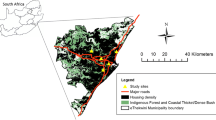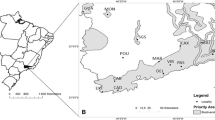Abstract
We assessed how well landscape metrics at 2, 5, and 10 km scales could explain the distribution of woodland bird species in the Mount Lofty Ranges, South Australia. We considered 31 species that have isolated or partially isolated populations in the region and used the Akaike Information Criterion to select a set of candidate logistic regression models. The 2 km distance was the most appropriate scale for a plurality of the species. While the total amount of area of native vegetation around a site was the most important determining factor, the effect of landscape configuration was also important for many species. Most species responded positively to area-independent fragmentation, but the responses to mean patch isolation and mean patch shape were more variable. Considering a set of candidate models for which there is reasonable support (Akaike weights > 0.10), 12 species responded negatively to landscapes with highly linear and isolated patches. No clear patterns emerged in terms of taxonomy or functional group as to how species respond to landscape configuration. Most of the species had models with relatively good discrimination (12 species had ROC values > 0.70), indicating that landscape pattern alone can explain their distributions reasonably well. For six species there were no models that had strong weight of evidence, based on the AIC and ROC criteria. This analysis shows the utility of the Akaike Information Criterion approach to model selection in landscape ecology. Our results indicate that landscape planners in the Mount Lofty Ranges must consider the spatial configuration of vegetation.
Similar content being viewed by others
References
Anderson D.R., Burnham K.P. and Thompson W.L. 2000. Null hypothesis testing: problems, prevalence, and an alternative. Journal of Wildlife Management 64: 912–923.
Andren H. 1994. Effects of habitat fragmentation on birds and mammals in landscapes with different proportions of suitable habitat: a review. Oikos 71: 355–366.
Bajema R.A. and Lima S.L. 2001. Landscape-level analyses of Henslow's sparrow (Ammodramus henslowii) abundance in reclaimed coal mine grasslands. American Midland Naturalist 145: 288–298.
Berry M.E. and Bock C.E. 1998. Effects of habitat and landscape characteristics on avian breeding distributions in Colorado foot-hills shrub. Southwestern Naturalist 43: 453–461.
Bryan B. 2000. Strategic Revegetation Planning in an Agricultural Landscape: a Spatial Information Technology Approach. Doctoral, University of Adelaide, Adelaide, South Australia.
Burnham K.P. and Anderson D.R. 1998. Model Selection and Inference: A Practical Information-Theoretic Approach. Springer-Verlag, New York, New York, USA.
Burnham K.P. and Anderson D.R. 2001. Kullback-Leibler information as a basis for strong inference in ecological studies. Wild-life Research 28: 111–119.
Elith J. 2000. Quantitative methods for modeling species habitat. In: Ferson S. and Burgman M. (eds), Quantitative Methods for Conservation Biology. Springer-Verlag, New York, New York, USA, pp. 39–49.
Elkie P., Rempel R. and Carr A. 1999. Patch Analyst User's Manual. Ontario Ministry of Natural Resources. Northwest Science and Technology, Thunder Bay, Ontario, Canada, Pages 16 +Append.
Estades C.F. 1999. Deciduous-forest bird communities in a fragmented landscape dominated by exotic pine plantations. Ecological Applications 9: 573–585.
Fahrig L. 1997. Relative effects of habitat loss and fragmentation on population extinction. Journal of Wildlife Management 61: 603–610.
Fahrig L. 1998. When does fragmentattion of breeding habitat affect population survival? Ecological Modelling 105: 273–292.
Fahrig L. 2002. Effect of habitat fragmentation on the extinction threshold: a synthesis. Ecological Applications 12: 346–353.
Fielding A.H. 1997. A review of methods for the assessment of prediction errors in conservation presence/absence models. Enviromental Conservation 24: 38–49.
Ford H.A., Barrett G.W., Saunders D.A. and Recher H. 2001. Why have birds in the woodlands of Southern Australia declined. Biological Conservation 97: 71–88.
Fortin M.J. and Gurevitch J. 1993. Mantel tests: spatial structure in field experiments. In: Sheiner S.M. and Gurevitch J. (eds), Design and Analysis of Ecological Experiments. Chapman and Hall, London, UK.
Franklin D.C. and Noske R.A. 1999. Birds and nectar in a monsoonal woodland: correlations at three spatio-temporal scales. Emu 99: 15–28.
Garnett S.T. and Crowley G.M. 2000. The Action Plan for Australian Birds 2000. Environment Australia.
Grey M.J., Clarke M.F. and Loyn R.H. 1997. Initial changes in the avian communities of remnant eucalypt woodlands following a reduction in the abundance of Noisy Miners Manorina melanocephala. Wildlife Research 24: 631–648.
Grey M.J., Clarke M.F. and Loyn R.H. 1998. Influence of the Noisy Miner Manorina melanocephala on avian diversity and abundance in remnant Grey Box woodland. Pacific Conservation Biology 4: 55–69.
Hobbs R.J. 2001. Synergisms among habitat fragmentation, live-stock grazing, and biotic invasions in southwestern Australia. Conservation Biology 15: 1522–1528.
Howe R.W. 1984. Local dynamics of bird assemblages in small forest habitat islands in Australia and North America. Ecology 65: 1585–1601.
Howell C.H., Latta S.C., Donovan T.M., Porneluzi P.A., Parks G.R. and Faaborg J. 2000. Landscape effects mediate breeding bird abundance in midwestern forests. Landscape Ecology 15: 547–562.
Jansen A. and Robertson A.I. 2001. Riparian bird communities in relation to land management practices in floodplain woodlands of south-eastern Australia. Biological Conservation 100: 173–185.
Jansson G. and Agelstam P. 1999. Threshold levels of habitat com-position for the presence of the long-tailed tit (Aegithalos cau-datus) in a boreal landscape. Landscape Ecology 14: 283–290.
Kirkpatrick S., Gelatt C.D. and Vecchi M.P. 1983. Optimization by simulated annealing. Science 220: 671–680.
Koenig W.D. 1999. Spatial autocorrelation of ecological phenomena. Trends in Ecology and Evolution 14: 22–26.
Koenig W.D. and Knops J.M.H. 1998. Testing for spatial autocorrelation in ecological studies. Ecography 21: 423–429.
Legendre L. and Legendre P. 1983. Numerical Ecology. Elsevier Science, Amsterdam, The Netherlands.
Legendre P. 1993. Spatial autocorrelation: trouble or new paradigm. Ecology 74: 1659–1673.
Loyn R.H., McNabb E.G., Volodina L. and Willig R. 2001. Modelling landscape distributions of large forest owls as applied to managing forests in north-east Victoria, Australia. Biological Conservation 97: 361–376.
Mazerolle M.J. and Villard M. 1999. Patch characteristics and landscape context as predictors of species presence and abundance: a review. Ecoscience 6: 117–124.
McDonnell M., Possingham H.P., Ball I. and Cousins E. 2002. Mathematical methods for spatially cohesive reserve design. Environmental Modelling and Assessment.
McGarigal K. and McComb W.C. 1995. Relationships between landscape structure and breeding birds in the Oregon Coast Range. Ecological Monographs 65: 235–260.
Metropolis N.A., Rosenbluth M., Rosenbluth A. and Teller E. 1953. Equation of state calculations by fast computing machines. Journal of Chemical Physics 21: 1087–1092.
Meyer J.S. and Irwin L.L. 1998. Influence of habitat abundance and fragmentation on the Northern Spotted Owls in Western Oregon. Wildlife Monographs 139: 1–51.
Mortberg U. and Wallentinus H. 2000. Red-listed forest bird species in an urban environment-assessment of green space corridors. Landscape and Urban Planning 50: 215–226.
Neave H.M., Cunningham R.B., Norton T.W. and Nix H.A. 1996. Biological inventory for conservation evaluation III. Relationships between birds, vegetation and environmental attributes in southern Australia. Forest Ecology and Management 83: 197–218.
Nias R. 1984. Territory quality and group-size in the Superb Fairy-wren Malurus cyaneus. Emu 84: 178–180.
Nias R. 1986. Nest-site characteristics and reproductive success in the Superb Fairy-wren. Emu 86: 139–144.
Paton D.C., Carpenter G. and Sinclair R. 1994. A second bird atlas of the Adelaide Region. South Australian Ornithologist 31: 151–264.
Pearce J. and Ferrier S. 2000. Evaluating the predictive performance of habitat models developed using logistic regression. Ecological Modelling 133: 225–245.
Possingham H. and Field S. 2001. Regional bird extinctions and their implications for vegetation clearance policy. In: Life Lines: Bulletin of the Community Biodiversity Network. pp. 15–16.
Possingham H.P., Ball I. and Andelman S. (eds) 2000. Mathematical Methods for Identifying Representative Reserve Networks. Springer-Verlag, New York, New York, USA.
Pulliam H.R. 1988. Sources, sinks, and population regulation. American Naturalist 132: 652–661.
Pulliam H.R. 1996. Sources and sinks: empirical evidence and population consequences. In: Rhodes O.E., Chester R.K. and Smith M.H. (eds), Population Dynamics in Ecological Space and Time. University of Chicago Press, Chicago, Illinois, USA.
Rosenberg K.V., Lowe J.D. and Dhondt A.A. 1999. Effects of forest fragmentation on breeding tanagers: a continental perspective. Conservation Biology 13: 568–583.
Saab V. 1999. Importance of spatial scale to habitat use by breeding birds in riparian forests: a hierarchical analysis. Ecological Applications 9: 135–151.
Saunders D.A. 1977. The effect of agricultural clearing on the breeding success of the White-tailed Black Cockatoo. Emu 77: 180–184.
Schmiegelow F.K.A. and Monkkonen M. 2002. Habitat loss and fragmentation in dynamic landscapes: avian perspectives from the boreal forest. Ecological Applications 12: 375–389.
Trzcinski M.K., Fahrig L. and Merriam G. 1999. Independent effects of forest cover and fragmentation on the distribution of forest breeding birds. Ecological Applications 9: 586–593.
Turner M.G., Gardner R.H. and O'Neill R.V. 2001. Landscape Ecology in Theory and Practice: Pattern and Process. Springer-Verlag, New York, New York, USA.
Tyre A.J., Tenhumberg B., Field S.A., Niejalke D., Parris K. and Possingham H.P. Improving precision and reducing bias in biological surveys by estimating false negative error rates in presence-absence data. Ecological Applications, in review.
Villard M., Trzcinski M.K. and Merriam G. 1999. Fragmentation effects on forest breeding birds: relative influence of woodland cover and configuration on landscape occupancy. Conservation Biology 13: 774–783.
Author information
Authors and Affiliations
Rights and permissions
About this article
Cite this article
Westphal, M.I., Field, S., Tyre, A. et al. Effects of landscape pattern on bird species distribution in the Mt. Lofty Ranges, South Australia. Landscape Ecology 18, 413–426 (2003). https://doi.org/10.1023/A:1026115807529
Issue Date:
DOI: https://doi.org/10.1023/A:1026115807529




